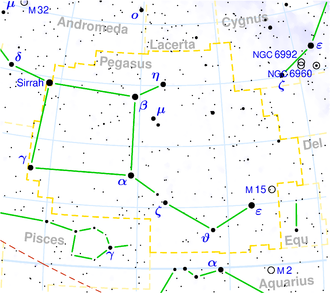NGC 7500
| Galaxy NGC 7500 |
|
|---|---|

|
|
| SDSS recording | |
| AladinLite | |
| Constellation | Pegasus |
|
Position equinox : J2000.0 , epoch : J2000.0 |
|
| Right ascension | 23 h 10 m 29.8 s |
| declination | + 11 ° 00 ′ 44 ″ |
| Appearance | |
| Morphological type | S0 |
| Brightness (visual) | 13.6 mag |
| Brightness (B-band) | 14.6 mag |
| Angular expansion | 2.1 '× 1.1' |
| Position angle | 125 ° |
| Surface brightness | 14.4 mag / arcmin² |
| Physical data | |
| Redshift | 0.035418 +/- 0.000103 |
| Radial velocity | 10,618 ± 31 km / s |
|
Stroke distance v rad / H 0 |
(481 ± 34) · 10 6 ly (147.6 ± 10.3) Mpc |
| history | |
| discovery | Lewis Swift |
| Discovery date | August 8, 1886 |
| Catalog names | |
| NGC 7500 • UGC 12399 • PGC 70620 • CGCG 431-008 • MCG + 02-59-004 • 2MASX J23102978 + 1100441 • GALEX ASC J231029.71 + 110042.8 | |
NGC 7500 is a lenticular galaxy of the Hubble type S0 in the constellation Pegasus in the northern sky . It is estimated to be 481 million light-years from the Milky Way and about 295,000 light-years across.
In the same area of the sky is u. a. the galaxy NGC 7519 .
The object was discovered by Lewis Swift on August 8, 1886 .
